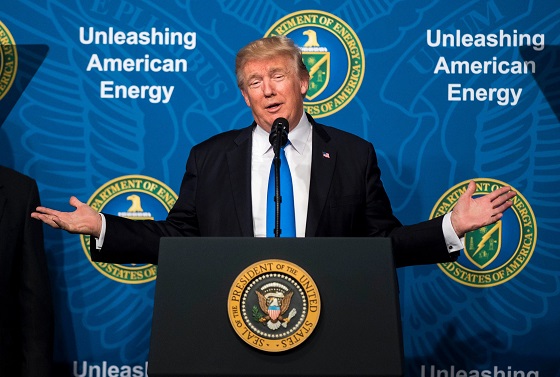Energy
A full-throated endorsement of the Secretary of Energy nominee Chris Wright.

In Praise of Chris Wright
Like others, we have watched with curiosity as President-elect Donald Trump has rolled out his nominees for the various leadership positions of his administration. Whatever your views on any particular candidate, an undeniable pattern has emerged. First, Trump is selecting people who strongly support the specific campaign promises on which he ran, and those chosen are vowing to implement them to the letter. Second, lack of prior government experience seems to be an attribute rather than a detriment. Finally, the helminthoid establishment in Washington appears utterly ill-prepared for the deluge that is set to befall them, and Trump can expect significant bipartisan resistance as it dawns on lawmakers just how literal he was being on the campaign trail.
Of particular interest to this publication were the President-elect’s positions on energy. During his many rallies and speeches, candidate Trump vowed to be extremely supportive of domestic energy production, promising to unleash a wave of new investment in oil, natural gas, coal, and nuclear energy. He also committed to ending participation in various international climate change initiatives, much to the horror of those on the progressive environmental left. The shackles of federal regulation would soon be lifted, he said, and the US would come to dominate the global energy scene once again.
Against this backdrop, President-elect Trump electrified those in industry by nominating Chris Wright to the position of Secretary of Energy on Saturday. We can think of no better person for the job.
Consider his impressive biography. Wright earned an undergraduate degree in mechanical engineering from the Massachusetts Institute of Technology (MIT) and did graduate work in electrical engineering at both MIT and the University of California, Berkeley. He was a pioneer in the development of US shale gas resources, creating enormous value for shareholders over the past two decades. He has grown his current company, Liberty Energy, into one of the premier energy industry service providers in North America. Finally, he is an investor in and board member of Oklo Inc., a next-generation small modular nuclear reactor (SMR) company that has seen its market cap soar in 2024.
Things get even more promising when one studies Wright’s policy positions on energy. In early 2024, Liberty Energy published a 180-page policy document titled “Bettering Human Lives,” and we are hard-pressed to find anything to disagree with. The ten “Key Takeaways” from the summary page read as follows:
1. Energy is essential to life and the world needs more of it!
2. The modern world today is powered by and made of hydrocarbons.
3. Hydrocarbons are essential to improving the wealth, health, and life opportunities for the less energized seven billion people who aspire to be among the world’s lucky one billion.
4. Hydrocarbons supply more than 80% of global energy and thousands of critical materials and products.
5. The American Shale Revolution transformed energy markets, energy security, and geopolitics.
6. Global demand for oil, natural gas, and coal are all at record levels and rising – no energy transition has begun.
7. Modern alternatives, like solar and wind, provide only a part of electricity demand and do not replace the most critical uses of hydrocarbons. Energy-dense, reliable nuclear could be more impactful.
8. Making energy more expensive or unreliable compromises people, national security, and the environment.
9. Climate change is a global challenge but is far from the world’s greatest threat to human life.
10. Zero Energy Poverty by 2050 is a superior goal compared to Net Zero 2050.
What’s not to like? The first nine of these takeaways are objectively true statements of fact, although few executives of publicly traded companies have had the courage to say them out loud. Wright has consistently done so throughout his career. The last is a brilliant reformulation of the climate change debate, as it forces a consideration of the impact on humans, not just the impact of humans.
Wright’s nomination is sure to trigger vigorous opposition by all the predictable people, and we hope he is well prepared to run the gauntlet of personal destruction that the left will undoubtedly use to derail him. Should he win approval in the Senate, Wright has the opportunity to be a historic and transformational figure. His talent, knowledge, leadership attributes, and track record of success make him more than qualified for the job. Count us among those excited at the prospect.
If you’re interested to hear from Wright himself, listen to this episode of Energy News Beat, featuring a discussion with Wright and yours truly, recorded in March of this year.
Thank you for reading. Please subscribe to access all articles and support our work.
Dan McTeague
Will this deal actually build a pipeline in Canada?

By Dan McTeague
Will Carney’s new pipeline deal actually help get a pipeline built in Canada? As we said before, the devil is in the details.
While the establishment and mainstream media cheer on the new pipeline agreement, there are specific details you need to be aware of.
Dan McTeague explains in his latest video.
Alberta
Premier Smith: Canadians support agreement between Alberta and Ottawa and the major economic opportunities it could unlock for the benefit of all

From Energy Now
By Premier Danielle Smith
Get the Latest Canadian Focused Energy News Delivered to You! It’s FREE: Quick Sign-Up Here
If Canada wants to lead global energy security efforts, build out sovereign AI infrastructure, increase funding to social programs and national defence and expand trade to new markets, we must unleash the full potential of our vast natural resources and embrace our role as a global energy superpower.
The Alberta-Ottawa Energy agreement is the first step in accomplishing all of these critical objectives.
Recent polling shows that a majority of Canadians are supportive of this agreement and the major economic opportunities it could unlock for the benefit of all Canadians.
As a nation we must embrace two important realities: First, global demand for oil is increasing and second, Canada needs to generate more revenue to address its fiscal challenges.
Nations around the world — including Korea, Japan, India, Taiwan and China in Asia as well as various European nations — continue to ask for Canadian energy. We are perfectly positioned to meet those needs and lead global energy security efforts.
Our heavy oil is not only abundant, it’s responsibly developed, geopolitically stable and backed by decades of proven supply.
If we want to pay down our debt, increase funding to social programs and meet our NATO defence spending commitments, then we need to generate more revenue. And the best way to do so is to leverage our vast natural resources.
At today’s prices, Alberta’s proven oil and gas reserves represent trillions in value.
It’s not just a number; it’s a generational opportunity for Alberta and Canada to secure prosperity and invest in the future of our communities. But to unlock the full potential of this resource, we need the infrastructure to match our ambition.
There is one nation-building project that stands above all others in its ability to deliver economic benefits to Canada — a new bitumen pipeline to Asian markets.
The energy agreement signed on Nov. 27 includes a clear path to the construction of a one-million-plus barrel-per-day bitumen pipeline, with Indigenous co-ownership, that can ensure our province and country are no longer dependent on just one customer to buy our most valuable resource.
Indigenous co-ownership also provide millions in revenue to communities along the route of the project to the northwest coast, contributing toward long-lasting prosperity for their people.
The agreement also recognizes that we can increase oil and gas production while reducing our emissions.
The removal of the oil and gas emissions cap will allow our energy producers to grow and thrive again and the suspension of the federal net-zero power regulations in Alberta will open to doors to major AI data-centre investment.
It also means that Alberta will be a world leader in the development and implementation of emissions-reduction infrastructure — particularly in carbon capture utilization and storage.
The agreement will see Alberta work together with our federal partners and the Pathways companies to commence and complete the world’s largest carbon capture, utilization and storage infrastructure project.
This would make Alberta heavy oil the lowest intensity barrel on the market and displace millions of barrels of heavier-emitting fuels around the globe.
We’re sending a clear message to investors across the world: Alberta and Canada are leaders, not just in oil and gas, but in the innovation and technologies that are cutting per barrel emissions even as we ramp up production.
Where we are going — and where we intend to go with more frequency — is east, west, north and south, across oceans and around the globe. We have the energy other countries need, and will continue to need, for decades to come.
However, this agreement is just the first step in this journey. There is much hard work ahead of us. Trust must be built and earned in this partnership as we move through the next steps of this process.
But it’s very encouraging that Prime Minister Mark Carney has made it clear he is willing to work with Alberta’s government to accomplish our shared goal of making Canada an energy superpower.
That is something we have not seen from a Canadian prime minister in more than a decade.
Together, in good faith, Alberta and Ottawa have taken the first step towards making Canada a global energy superpower for benefit of all Canadians.
Danielle Smith is the Premier of Alberta
-

 Automotive1 day ago
Automotive1 day agoTrump Deals Biden’s EV Dreams A Death Blow
-

 Alberta2 days ago
Alberta2 days agoPremier Smith: Canadians support agreement between Alberta and Ottawa and the major economic opportunities it could unlock for the benefit of all
-

 Focal Points2 days ago
Focal Points2 days agoPharma Bombshell: President Trump Orders Complete Childhood Vaccine Schedule Review
-

 Censorship Industrial Complex2 days ago
Censorship Industrial Complex2 days agoFrances Widdowson’s Arrest Should Alarm Every Canadian
-

 Opinion2 days ago
Opinion2 days agoCountry music star Paul Brandt asks Parliament to toughen laws against child porn
-

 Automotive1 day ago
Automotive1 day agoCanada’s EV Mandate Is Running On Empty
-

 Business22 hours ago
Business22 hours agoWhy Does Canada “Lead” the World in Funding Racist Indoctrination?
-

 Alberta2 days ago
Alberta2 days agoA Memorandum of Understanding that no Canadian can understand








